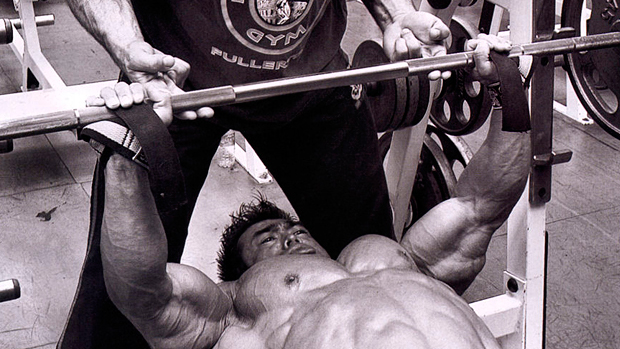A training program doesn't have to be complicated to work. In fact, sometimes the most simplistic routines can be the most exhaustive and result-producing. Take the old school 100-rep program guys like Arnold once used to "shock" their muscles into new growth. Just pick a good compound exercise and knock out 100 reps. Simple, huh? Sure, but it's not easy.
The catch is that you load up the bar with your regular training weight. Maybe it takes you seven sets to reach 100 reps, maybe it takes you fifteen. Doesn't matter, as long as you hit 100 reps. Arnold sometimes used this method with chin-ups. His goal was to reach 100 reps regardless of how many sets it took.
We've tweaked this classic approach to training and come up with what we call the 100/100 routine. This is a chest and back program but you can apply a variation of it to any opposing muscle groups: quads and hams, biceps and triceps, etc. It's simple; after a warm-up and an adequate stretching session, you're going to perform only two exercises for the whole workout: the bench press and the chin-up. Your goal is to get 100 reps of each.
To do this you'll first load up the bar with a weight you can bench press for about 15 reps. Do one set and rest for two to three minutes. Now head to the chin-up bar and get as many bodyweight chins as possible. Rest again and then it's back to the bench. Continue this process in superset fashion until you get 100 reps of each exercise.
Tips
• Use a wide variety of grips with the chin-up as you go along. You might start with a wide, palms facing away grip. A few sets later switch to a medium grip with your palms facing toward you. Read our Back to Basics (link to issue 100) article for more chinning options.
• When benching, alternate how you space your hands on the bar. Start with a medium grip and later in the workout switch to a super wide grip, or whatever. As with changing your grip on the chin-up, this will add variety and provide a variety of stressors to the muscle.
•Most people will end up hitting 100 reps in the bench press before they do with the chin-up, especially if they're big guys. No problem. If you're only on rep 86 of your chins and are already finished with your presses, just rest between sets and finish them up. On the other hand, if you're one of those strong, wiry guys who can hit 100 chins-ups in two sets, then strap on some weight with a dipping belt, hold a dumbbell between your feet, or wear a weighted vest.
• Expect your rep ranges to fall after a few sets. This is okay and expected. You may get 15 reps your first set and only 10 by your fourth set. Your last couple of sets may only be doubles or triples. Again, no problem, just keep going until you reach 100. The next time you try the routine, try to do it in one less set than before.
• Don't attempt to train biceps or triceps (and maybe even shoulders) for a couple of days after this. Trust us, they'll be plenty fatigued for a day or two without any direct work.
• We recommend you try the 100/100 routine once every four to six weeks or whenever you need a change of pace. If you choose to use it as your core chest and back workout, use it for only about three weeks, once every five to seven days, and then switch to a new program.
• If 100/100 is too much for you at first, try 75/75 or 50/50. If you fall below that, your name better be Samantha or Amber.
• Don't freak out if you're down to doing only a couple of reps per set by the time you reach 100, even if your partner's reps only fall from 15 to 12. You just learned a little accidental lesson about muscle fiber types and genetics. What happens is that guys who have been lifting a long time are able to achieve high intensity much, much, easier than guys who are newbies. After years of lifting, they can recruit a whole lot more muscle fibers than Mr. Average. Consequently, the experienced guys expend more energy in lifting their weights, and consequently are like wet dish rags by the end of the workout.
• You might consider making notes in your training log about what rep you're on after each set. As fatigue and pain sets in, a little voice may try to convince you you're on rep 92 when you're really on rep 81. This little voice may come from your training partner as he's lying on the floor trying not to black out, or it might even come from your own head. Don't listen to either and finish your reps.
Two muscle groups, two exercises, 200 reps in all. Simple? Yep. Effective? Yep. Tough? You betcha! Give it a shot.




